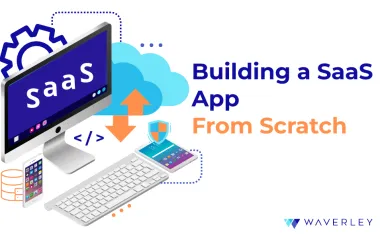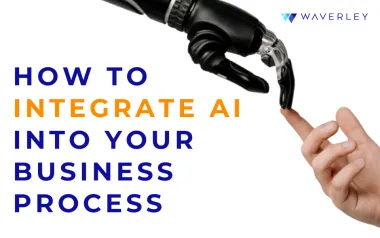How to Develop an AI SaaS Product
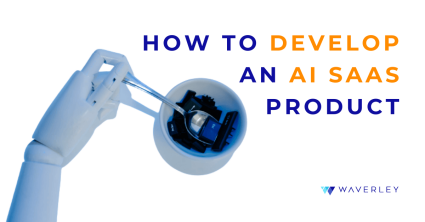
Contents
The combination of cloud-based software and artificial intelligence has brought about an important shift that has a significant effect on the state of technology today. The demand for AI-powered SaaS products is growing at an unheard-of rate as both organizations and consumers look for smarter, more effective solutions. In this article, we look at the importance of artificial intelligence (AI)-powered SaaS products and offer advice on how to successfully navigate the thrilling process of developing one.
What Exactly Is an AI SaaS (AIaaS)?
Artificial Intelligence as a Service, or AI SaaS, is completely changing how people may access and use AI technologies. It combines the scalability and flexibility of the use of the Software as a Service (SaaS) concept with the capability of artificial intelligence. Through cloud-based software, AI SaaS solutions provide AI functionality and services, opening up advanced AI capabilities to a wide audience through subscription-based models. The key concepts of scalability, affordability, accessibility, and personalization form the foundation of this design. It democratizes AI use and adapts it to a variety of specialized use cases, enabling organizations of all sizes to benefit from AI without the weight of high upfront expenses and expertise.
AI has a revolutionary effect on the SaaS industry. In SaaS application development, it improves automation, simplifies workflows, offers deeper insights, and customizes user experiences. SaaS solutions driven by AI provide predictive capabilities to support forecasting and decision-making, giving businesses a competitive advantage in data-driven decision-making. A new era of creativity and efficiency in the digital environment is being ushered in by AI SaaS, which combines the best aspects of both worlds: the effectiveness and accessibility of SaaS with the transformative power of AI.
AIaaS Market Trends
Over the next seven years, the worldwide AI industry is predicted to grow at an astounding CAGR of 37.3% (2023–2030) and reach a valuation of $1,811.8 billion. So, take a look at the following list that shows why AIaaS is gaining popularity, reflecting the ever-increasing demand for AI-powered solutions. These developments shed light on the market dynamics and growth prospects for AIaaS.
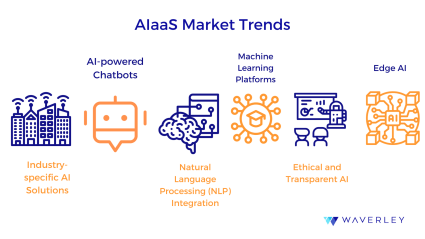
- Industry-specific AI Solutions: Companies are looking for AIaaS products that are specialized to their sector and meet their specific requirements. A number of industries, including manufacturing, banking, healthcare, and e-commerce, are implementing these solutions to handle industry-specific problems including fraud detection, suited shopping suggestions, medical diagnosis, and predictive maintenance.
- AI-powered Chatbots: The usage of virtual assistants and chatbots driven by AI is growing. These chatbots improve customer assistance and service by answering questions, fixing problems, and giving 24/7 information. IBM Watson Assistant and Zendesk’s Answer Bot are two successful instances.
Read about how Waverley developed a GPT-Powered Chatbot for Customer support.
- Natural Language Processing (NLP) Integration: NLP is becoming a crucial component of AIaaS solutions, allowing companies to comprehend and analyze unknown information. Two examples of AI SaaS solutions with an NLP focus are Amazon Comprehend and Google Cloud Natural Language.
- Machine Learning Platforms: Machine learning platforms can help companies analyze their data and extract business insights in no time, provided that they’ve set up the right data collection for machine learning since data is key here. The top instances are Microsoft Azure Machine Learning and Google Cloud AI Platform.
- Edge AI: AI algorithms are increasingly being deployed at the edges close to the data stream. As demonstrated by AI-powered security cameras, driverless cars, and Internet of Things devices, this movement is motivated by the demand for real-time processing and decreased latency.
- Ethical and Transparent AI: Fairness, accountability, and transparency in AI decision-making are given top priority in the AIaaS products that are emerging as a result of the increased focus on ethical AI and openness. Fairness evaluations and AI Explainability tools are becoming more and more significant.
Now, here are some real and Successful examples of AI SaaS Products:
- IBM Watson: IBM Watson provides AI solutions for a range of sectors, such as banking, healthcare, and customer support. AI-driven programs like Watson Assistant and Watson Discovery are powered by it.
- Salesforce Einstein: Einstein, the AI platform from Salesforce, improves customer relationship management by offering analysis, forecasts, and suggestions.
- UiPath: Automation of repetitive operations and processes is made possible for enterprises by UiPath’s robotic process automation (RPA) with AI capabilities.
- Twilio Autopilot: An AI-powered conversational platform called Twilio’s Autopilot assists companies in creating chatbots, virtual assistants, and interactive voice response systems.
- H2O.ai: H2O.ai offers a range of machine learning solutions that serve use cases including identifying fraud and maintenance prediction, giving businesses access to AI and data science skills.
Benefits of AI for SaaS Businesses
Businesses and customers alike benefit greatly from the incorporation of Artificial Intelligence (AI) into Software as a Service (SaaS) products. Let’s examine the main advantages of using AI in the SaaS industry:
| Benefits for Business | Benefits for Users |
|---|---|
| Enhanced Efficiency: SaaS systems with AI capabilities automate repetitive operations, minimizing the need for human interaction and enhancing corporate productivity. Costs are reduced and productivity is higher as a result. | Better Decision Support: SaaS solutions with AI capabilities can help customers make better decisions by offering data-driven insights and suggestions. |
| Personalization: SaaS offerings powered by AI have the ability to customize user experiences by providing highly tailored services, recommendations, and content. Customers are happier and user engagement is much better. | Predictive Features: SaaS apps that use AI are able to anticipate user preferences and wants and provide recommendations and solutions in a timely manner. |
| Data-Driven Insights: SaaS systems with AI analytics built-in allow firms to gain deeper insights from data, facilitating better strategy development, trend forecasting, and decision-making. | Improved User Experience: AI SaaS apps offer recommendations, help, and personalized information to make the user experience more intuitive and user-friendly. |
| Scalability: AI SaaS solutions are versatile and can be quickly scaled to meet changing business needs and expanding user bases at different stages of corporate growth. | Time Savings: With AI-driven automation, users can save time by having time-consuming operations completed quickly and precisely. |
| Competitive Edge: Companies can maintain a competitive edge by offering cutting-edge, AI-enhanced services and by staying ahead of market trends by utilizing AI-powered SaaS products. | Cost-Effective Solutions: These are frequently provided by AI-powered SaaS, particularly in sectors like finance where AI helps optimize investments and lower risks. |
| Cost Savings: AI SaaS lowers labor costs and the need for substantial human resources by automating processes and tasks, which results in significant cost savings. | Enhanced Security: By offering threat detection and data protection, AI can strengthen security in SaaS solutions and guarantee the security of user data. |
8 Steps to Create an AI SaaS Product
Creating a Software as a Service (SaaS) solution with AI capabilities is a complex process that needs to be carefully planned and carried out. The following are the crucial phases that will lead you through the procedure:
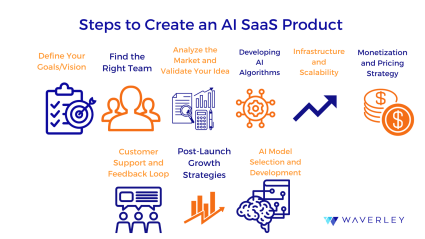
1. Define Your Goals/Vision
Having specific goals is essential for any AI SaaS project to succeed. Clearly state the issue that your product will address, identify the people who will use it, and set quantifiable goals. The development process is guided by clearly stated goals, which also act as benchmarks for success.
Our AI SaaS solution seeks to address the difficulty of interpreting and analyzing complicated data. It reduces the amount of time and skill needed for analysis by streamlining the extraction of useful insights from large and diverse datasets. Businesses are able to make data-driven decisions more effectively by automating this process.
In order to help data analysts, business decision-makers, and researchers gain quick insights, our AI SaaS platform aims to simplify complicated data analysis. Our objectives include providing actionable insights, maintaining scalability and customization, facilitating effective data interpretation, and creating an intuitive user experience. Target customers include major businesses, SMEs, and academic institutions. Our user personas include professional data analysts looking for productivity, non-technical decision-makers in need of clear insights, and academics needing reliable, easy-to-use tools for their study.
2. Find the Right Team
Your project’s success depends on building the best team possible with experience in the relevant field. This is a thorough guide on finding, assessing, and choosing a software development team to bring your AI SaaS product idea to life. Read carefully the following steps:
- Utilize Online Platforms: Look through reliable websites like Clutch, Upwork, and LinkedIn to find software development teams. Websites like Clutch offer ratings and evaluations that shed light on the capabilities and performance of different businesses. Also, engaging on tech forums, like Stack Overflow and GitHub, to find developers or teams who are well-established in the SaaS and AI development fields is a good option. Participating in these forums can reveal a team’s level of technical proficiency.
- Assess Experience and Expertise: Carefully review prospective teams’ portfolios. Seek out projects that complement your goal for your AI SaaS product, highlighting the breadth and depth of their industry knowledge. Consider looking for case studies and testimonials from previous clients to learn more about the team’s ability to work together and solve problems.
- Technical Proficiency Is Important: Evaluate the team’s knowledge of the tools and technologies required for developing AI and SaaS applications. Make sure they understand cloud computing, machine learning frameworks, and other pertinent technology. Find out about their development procedures and coding standards.
- Provide Effective Communication Channels: Project success depends on clear communication. To guarantee a seamless workflow, assess the team’s reaction times, communication channels, and collaboration tools. Don’t forget to recognize the project management methodology used by the team. Agile development approaches, which promote flexibility and iterative development, are frequently effective for dynamic projects.
- Consider Legal and Security Factors: Make sure the group is willing to sign the needed contracts that include the specifics of the project, deadlines and roles – such as PSA and SOW. Explain terms pertaining to secrecy and intellectual property, sign an NDA. Verify that they follow industry guidelines to protect user data and your AI SaaS product.
- Financial Transparency: Look for clear cost breakdowns and transparent pricing structures. Talk about payment plans based on project milestones and any supplementary expenses that might arise. Long-term success depends on having a team that can change with your needs.
Plus: If it’s possible, take a look at the selected teams’ locations. Observing their workspace, organization, and teamwork directly might provide important details about their dedication to excellence.
3. Analyze the Market and Validate Your Idea
Examine the market before starting development to ensure that your idea is sound.
- Make data-driven projections
- Evaluate the competition
- Conduct in-depth market research.
Verifying that there is a true market need for your AI SaaS offering is crucial.
To ensure the success of your AI SaaS product, thorough market research is important. This involves analyzing competitors, industry trends, and customer needs to identify unmet market opportunities. There are also research organizations and companies that can conduct market overview on demand, or provide ready-made reports on the latest trends and tendencies in your field, such as Gartner, or McKinsey.
Additionally, validating our product idea through user feedback is vital. Engaging potential users via surveys, interviews, and prototype testing allows us to refine our solution, address user pain points, and align the product more closely with market demands. This iterative process of market research and user feedback is fundamental in crafting a product that resonates effectively with the identified market.
4. Developing AI Algorithms
Finding, gathering, and honing datasets in a methodical manner are all part of the process of preparing data for AI algorithms. The first stage in training AI algorithms is to identify the necessary data sources. After that, a thorough plan for gathering data is established, including how to obtain the required datasets. In order to provide diversity and sufficient data for reliable model training, this may entail gathering data from a variety of sources, such as databases, APIs, or outside sources. The data is cleaned and preprocessed after it is gathered to guarantee its accuracy and dependability. To produce a consistent, high-quality dataset, data preparation entails addressing missing values, normalizing data, and converting raw data into a format that can be used. Data cleaning ensures the correctness and integrity of the information used by locating and fixing mistakes, anomalies, or inconsistencies within the dataset.
5. Infrastructure and Scalability
It is important to design a solid and expandable infrastructure. Use cloud computing services such as Google Cloud, Azure, or Amazon Web Services to guarantee excellent speed and availability. Adopt best practices for data storage, load balancing, and redundancy. Scalability is necessary to handle expanding user populations and data quantities.
Check out our comparison of AWS vs Azure vs GCP for your cloud infrastructure.
So, careful planning and execution are needed to support AI-driven SaaS by designing a solid and scalable infrastructure. Using serverless solutions and cloud computing is essential to building an adaptable infrastructure that can handle changing user needs and workloads. Cloud-based solutions allow for dynamic resource allocation because they are scalable without requiring large hardware investments. It’s also critical to provide excellent performance, security, and availability in this architecture. By putting in place redundancy, strong security measures, and performance optimization, a platform may be made more dependable and responsive for users, improving their experience while preserving the confidentiality and integrity of data.
6. Monetization and Pricing Strategy
It takes careful consideration to develop a profitable pricing plan. Depending on the characteristics of the product and the market, the best pricing model – subscription-based, freemium, or usage-based—must be chosen. Selecting the right model requires an understanding of our user base and their willingness to pay. Furthermore, providing value while satisfying a range of user needs depends on clearly identifying different price tiers and matching feature sets. With the help of this tiered approach, consumers can select a plan that best suits their needs, increasing their sense of return on investment in the product.
We must continuously improve our pricing models and feature sets in order to develop a plan for pricing optimization and value delivery. Our pricing approach is optimized through ongoing examination of user behavior, market developments, and the competitive environment. We may modify features and pricing tiers in response to customer feedback and market demands thanks to this iterative methodology, which guarantees that the value offered outweighs the cost. Finding a balance where customers believe the benefits of the product outweigh the price is the aim in order to maximize customer happiness and retention.
7. Customer Support and Feedback Loop
Provide top-notch customer service to increase user happiness. Create avenues for user input and participate in an ongoing feedback cycle. You may fix problems and improve the user experience by using user insights to drive product improvement. Check these three principal checkpoints:
- Provide Customer Support Channels and Resources: In order to properly handle user questions and issues, it is imperative to establish strong customer support channels. Users can receive quick assistance by implementing multi-channel support, which includes chat, email, and knowledge bases. Our goal is to increase customer happiness and product trust by providing clear resources and prompt support.
- Actively Gather and Examine User Feedback: Knowing user experiences and pain spots requires regular user feedback collection and analysis. User behavior analysis, comment forms, and surveys all offer insightful data. We try to find areas for development and better match the needs of our consumers with the product by actively listening to them.
- Utilize input to iterate and enhance the product going forward: Product development must include customer feedback into an iterative improvement process. We iterate and improve the product regularly, using insights gleaned from customer input. By taking this method, the product is guaranteed to adapt to the requirements and preferences of the user, providing more value and an improved solution in the end.
8. AI Model Selection and Development
There are a number of crucial phases in the process of choosing and developing AI models that indicate the way to building robust and efficient models. Check the following steps:
- Model Choice
The first step in the process is to choose the best algorithm by analyzing the complexities of other possibilities, such as creating bespoke models or using pre-trained ones. Whether using already-existing pre-trained models or creating custom models to meet unique needs, each strategy has unique benefits. - Preparing Data
Any successful model starts with high-quality data and careful data separation. Robust model creation is predicated on ensuring data quality by means of cleansing and normalization, as well as carefully dividing data into sets for training, validation, and testing. - Validation and Training
In order to ensure the model’s correctness and generalizability, this stage entails training and fine-tuning it, optimizing hyperparameters, and rigorously verifying and cross-validating its performance. - Assessment of Models
The value of the model is evaluated using testing data and a variety of criteria to assess its effectiveness. - Iteration and Optimization
The iterative process of developing a model entails frequent retraining and ongoing fine-tuning to improve performance and adjust to changing data. - Model Implementation
Deployment into real-world applications becomes essential after the model is polished, guaranteeing a smooth transition from development to useful application. - Ongoing Enhancement
The journey eventually circles back, stressing constant development, refining the model, and adjusting to evolving data and user requirements, creating an endless cycle of improvement and optimization.
9. Post-Launch Growth Strategies
The process doesn’t end with the debut of the product; instead, it becomes an ongoing endeavor to increase sales and customer base. A deliberate combination of marketing campaigns, forming partnerships, and tenacious innovation is needed to remain competitive in the market. Continuous improvements and changes to our AI SaaS solution are essential, requiring close attention to analytics, user input, and changing market trends.
The cornerstone of our AI SaaS success in the area of customer acquisition and retention is essential methods. Building strong customer care systems, conducting focused marketing campaigns, and offering free trials or demos to draw in new customers are all necessary for starting and maintaining a relationship with a customer. Personalized user experiences, prompt updates, and attentive customer service are essential for maintaining retention. Sustaining product features and services to meet changing user needs is equally important.
Our solution will continue to evolve in response to our user base’s changing needs thanks to thorough market research and ongoing feedback loops. Through feature enhancement, we can both attract new customers and keep the ones we already have. This will help us establish our product’s position in the market and ensure its long-term success.
Tips for Creating an AI SaaS Product
As we showed previously, the process of developing an AI SaaS product is continuous and demands dedication to ethics, compliance, high-quality data, and continual progress. By following these pointers, you may successfully negotiate the difficulties and nuances of AI development and make sure that your product continues to be useful, efficient, and user-focused.
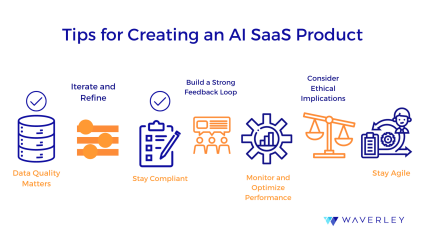
- Data Quality Matters: Your data’s quality is of the highest priority. Make sure the data you have is reflective of the issue you are trying to solve, accurate, and tidy. Robust AI algorithms are built on top of high-quality data.
- Iterate and Refine: The secret is iterative development. Get user input while developing a minimum viable product (MVP). Utilize these suggestions to iteratively enhance the features and functionality of your AI SaaS application.
- Stay Compliant: Respect industry-specific compliance standards and data protection laws, such as HIPAA, GDPR, and others. Make sure your AI SaaS solution manages user data in a legally compliant and safe manner.
- Build a Strong Feedback Loop: Provide strong avenues for user input and pay attention to what your customers have to say. Take their suggestions into account while developing new products to solve problems and adapt to changing market demands.
- Monitor and Optimize Performance: Keep an eye on the functionality of your AI algorithms at all times. Determine any flaws, bottlenecks, or less-than-ideal outcomes, then try to improve the accuracy and efficiency of your algorithms.
- Consider Ethical Implications: While creating AI, ethical issues must be taken into account. Pay attention to user consent, transparency, fairness, and biases. Aim to develop AI SaaS solutions that are morally and practically sound as well as effective.
- Stay Agile: Use agile development methodologies. To offer incremental changes, divide your project into digestible jobs and work in sprints. You are able to adjust to shifting demands and market conditions because of this adaptability.
Waverley’s Experience
With several decades of experience, Waverley Software has created software solutions that support the growth of enterprises. We have worked with nearly every kind of software product, including SaaS apps, from early-generation mobile apps to contemporary AI, robots, and IoT devices.
We currently use a wide range of technologies to develop connected devices, cloud computing, websites, mobile apps, and desktop software. Our customers benefit from our access to large talent pools of software development specialists, time zone proximity, and flexible pricing thanks to development centers located all over the world. Here are a few examples of the AI SaaS software we helped our clients create:
- An AI model for processing customer support queries. By working with our SaaS client, any company can automate the handling of their customer messages. Our powerful yet flexible AI model independently processes customer messages, recognizes the intent (tech issue, complaint, request, question about the product, pricing, etc.) and helps forward queries to the right people to be processed.
- For a localization SaaS company, we built software that enables conversational AI through advanced data collection, data annotation and data validation.
- Our AI engineers also developed an AI-powered ideation assistant. We created an Ideation Tool in the form of a physical smart speaker that acts as a virtual Ideation Facilitator. It is able to perceive and reproduce human oral speech so that it substitutes for a live person and can hold a natural conversation on absolutely any topic.
Creating an AI SaaS Product: Conclusion
The development of a Software as a Service (SaaS) solution driven by AI (AI as a Service) offers a tremendous chance for innovation and commercial expansion. You can create an AI SaaS product that fulfills user needs and stands out in a crowded market by adhering to a strategic roadmap that includes setting specific goals, putting together the correct team, conducting market research, and using an iterative approach to development. Recall that crucial elements of success include data quality, compliance, ethical considerations, and the creation of a robust feedback loop. Your AI SaaS solution will remain relevant and successful with consistent monitoring, optimization, and adaptability in your approach.
It’s usually helpful to enter this process by getting advice and assistance from professionals in the area like us. Our team of specialists is available to help you if you want to learn more about AI SaaS product development. We can guide you through the nuances and complexity of this fascinating and quickly changing industry thanks to our extensive expertise and experience. Please get in touch with our team if you would like individualized advice and insights for your particular project.
The landscape of AI SaaS products is always changing, but your business can take advantage of this game-changing technology to produce creative solutions that propel success if you have the correct mindset and know-how.
Transform your software with the brilliance of AI
FAQ
What is an AI SaaS platform?
An artificial intelligence-integrated cloud-based software solution is called a Software as a Service (SaaS) AI platform. It provides customers with AI features on a subscription basis, making AI technologies accessible and useful to both individuals and enterprises without requiring a high level of in-house AI knowledge.
Where to find an AI software development company?
You can find AI software development process companies through various means:
- Online platforms and marketplaces like Upwork, Toptal, and Clutch.
- Referrals from business contacts and industry peers.
- Local or global IT and AI associations and communities.
- Attending industry conferences and events.
- Consulting with technology-focused recruitment agencies.
What is the future of the AI-powered SaaS industry?
The SaaS sector that uses AI has a bright future. SaaS integration with AI is anticipated to increase further, as AI-enhanced solutions proliferate across many industries. AI SaaS solutions should provide increasingly more advanced features as AI technologies develop, improving automation, data analysis, and personalization. The sector will also see a greater emphasis on ethical AI and observing data protection laws.
Can I integrate ChatGPT into my SaaS?
It is possible to integrate ChatGPT into your SaaS, but doing so usually involves working with OpenAI and abiding by their licensing and usage guidelines. If you want to add a ChatGPT integration into your SaaS solution, you might need to look for special license or cooperation opportunities with OpenAI.
How much does it cost to create an AI-based SaaS platform?
Depending on the number of variables, including the complexity of the AI algorithms, the size of the development team, the volume of data processing needed, and the project’s scope, the cost of creating an AI-based SaaS platform can vary greatly. To obtain a more precise estimate that takes into account the particular requirements of your project, it is imperative that you speak with companies that offer AI development services specialists. Depending on the project’s size and complexity, costs might vary from tens of thousands to millions of dollars.
Elevate your AIaaS product with our development expertise.


